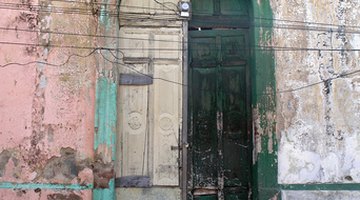What Are the Causes of Deterioration in Buildings?
There are many reasons that a building deteriorates, many of them having to do simply with exposure to the elements. Depending on what a building is made of, exposure to weather over time will lend itself to deterioration unless maintenance is regularly performed.

Builders should consider the area in which they are building before choosing certain stones and building materials.
Concrete Corrosion
Many modern buildings created during the 20th century were made from concrete, and in recent years, deterioration of the concrete has begun. The main reason for concrete deterioration is corrosion, and there are two main categories of concrete corrosion — general corrosion from carbonation and pitting corrosion from chloride ions. Carbonation exposure to reinforcement structures over long periods can cause widespread cracking of the concrete. Exposure to chloride ions from water that leaks to the concrete can cause pitting corrosion and deterioration.
Salt Crystallization
Salt crystallization is a common reason that buildings made of stone suffer from deterioration. Salt crystallization tends to effect more porous stones. Typically, salt enters the stone through the air and into the pores, where it is then crystallized. It causes the stone to deteriorate, usually into a fine powder. Salt is often the result of the mixing of air pollutants and stone. It also comes from ground water, sea spray, chemical cleaners and salt used to de-ice.
Frost Damage
Another element that can lead to deterioration is frost. Buildings made of stone in areas where the buildings are exposed to freezing temperatures as well as precipitation are susceptible to this damage. Frost damages stones with small pores more than it does those with larger pores. It is believed that many buildings built in the northern portion of the United States will suffer from frost damage, as many of these buildings are created from frost-susceptible stone.
Microbiological Growth
It is not always the weather that affects the deterioration of a building. Sometimes, life itself takes a toll on a building, depending on the area it was built in and the type of material used in construction. Plants and plant roots, ivy, birds and microorganisms have been known to aid in the decay of buildings. Microorganisms, including bacteria, fungi and algae, cause the most damage as they attack carbonate and silicate minerals with acid and other chemicals. These minerals are found in certain kinds of stone.
The Drip Cap
- There are many reasons that a building deteriorates, many of them having to do simply with exposure to the elements.
- Depending on what a building is made of, exposure to weather over time will lend itself to deterioration unless maintenance is regularly performed.
- Salt crystallization is a common reason that buildings made of stone suffer from deterioration.
- It causes the stone to deteriorate, usually into a fine powder.
- Frost damages stones with small pores more than it does those with larger pores.
References
Writer Bio
Catherine Copeland has been writing professionally since 2005. Her articles have been published in newspapers such as "The Jackson Citizen Patriot" and "The State News." Copeland holds a Bachelor of Arts in journalism from Michigan State University.
Photo Credits
- door image by charles taylor from Fotolia.com
- door image by charles taylor from Fotolia.com
More Articles



